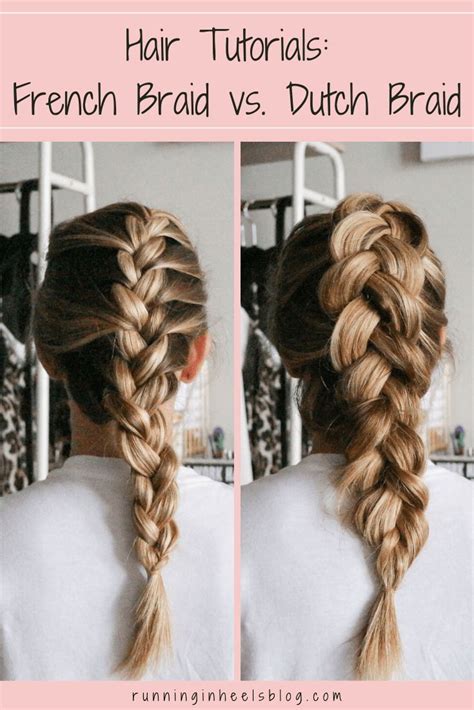Whether you’re an experienced hairstylist or a novice braider, the timeless allure of intricate braids knows no bounds. Among the vast array of plaiting techniques, the French braid and Dutch braid reign supreme, each boasting unique characteristics and captivating aesthetics. Join us as we embark on an in-depth exploration of these iconic braids, unraveling their historical roots, highlighting their key differences, and providing step-by-step guides to help you master the art of creating both styles.

French Braid vs. Dutch Braid: A Tale of Two Classics
The French braid, also known as the “tresse française,” has been enchanting hair enthusiasts for centuries. Originating in the French countryside, this elegant braid is effortlessly recognizable by its intricate overhand weave that conceals the sections of hair used in its construction. The Dutch braid, on the other hand, is a relatively modern innovation, first gaining popularity in the Netherlands during the mid-20th century. This striking braid features an underhand weave, resulting in a distinct raised appearance that sets it apart from its French counterpart.
Key Differences: Unraveling the Nuances
While both French and Dutch braids offer visually stunning results, their constructions diverge in several key aspects:
- Weaving Technique: French braids utilize an overhand weave, where each strand is passed over the center section, while Dutch braids employ an underhand weave, passing strands underneath the center section.
- Appearance: French braids create a flat, cohesive look due to the overhand weave, while Dutch braids appear raised and more voluminous due to the underhand weave.
- Versatility: French braids are highly versatile, lending themselves to a wide range of styles from classic to modern, while Dutch braids are typically more formal and traditional.
Mastering the Art: Step-by-Step Guides
Creating a French Braid:
- Start with freshly brushed hair and divide it into three equal sections.
- Cross the right section over the center section.
- Cross the left section over the new center section.
- Repeat steps 2 and 3, continually adding hair from the sides into each section as you cross them.
- Secure the braid with an elastic band at the end.
Creating a Dutch Braid:
- Begin with brushed hair and divide it into three equal sections.
- Cross the right section under the center section.
- Cross the left section under the new center section.
- Repeat steps 2 and 3, incorporating hair from the sides beneath each section as you cross them.
- Secure the braid with an elastic band when complete.
The Perfect Braid for Every Occasion
When selecting between a French braid and a Dutch braid, consider the occasion, hair type, and desired effect.
- Formal Events: Dutch braids are an excellent choice for formal occasions such as weddings, prom, or special ceremonies due to their elegant and sophisticated appearance.
- Casual Wear: French braids offer a more versatile option for everyday wear, blending effortlessly with both casual and dressy attire.
- Thick Hair: Dutch braids are well-suited for thick hair, accentuating volume and creating a striking visual impact.
- Fine Hair: French braids can enhance the appearance of fine hair by creating a fuller look.
Tips and Tricks
- For a more secure braid, dampen hair before braiding to increase grip.
- Apply a small amount of hairspray to the finished braid to minimize flyaways.
- Incorporate accessories such as ribbons or beads into your braids for a touch of personality.
- Experiment with different parting patterns to create unique braid variations.
Pros and Cons
French Braid
Pros:
– Versatile and suitable for everyday wear
– Creates a flat, cohesive appearance
– Adds volume and enhances the appearance of fine hair
Cons:
– Can be time-consuming to master
– May not hold as securely on thick or slippery hair
Dutch Braid
Pros:
– Raised and voluminous appearance
– Elegant and sophisticated for formal events
– Well-suited for thick or fine hair
Cons:
– May not be as versatile as a French braid
– Can look too bulky on some hair types
Embracing Innovation: The Future of Braiding
As the realm of hair styling continues to evolve, the French and Dutch braids remain foundational techniques. However, contemporary hairstylists are pushing the boundaries of these classic styles by introducing innovative approaches that fuse traditional elements with modern flair.
- Inverted French Braid: This technique creates a French braid that appears inside-out, showcasing the underside of the weave for a unique and eye-catching effect.
- Multi-Strand Dutch Braid: By incorporating more than three strands, stylists are creating intricate and voluminous braids that make a bold statement.
- Rope Dutch Braid: This innovative twist on the Dutch braid involves twisting two strands of hair before incorporating them into the underhand weave, resulting in a striking rope-like appearance.
Conclusion
The French braid and Dutch braid are two iconic hair styling techniques that offer distinct advantages and captivating aesthetics. Whether you’re seeking a classic and versatile everyday braid or a glamorous and formal updo, these techniques provide endless possibilities for creating beautiful and unforgettable hairstyles. With a little practice and creativity, you can master the art of both braiding styles and elevate your hair game to new heights.
